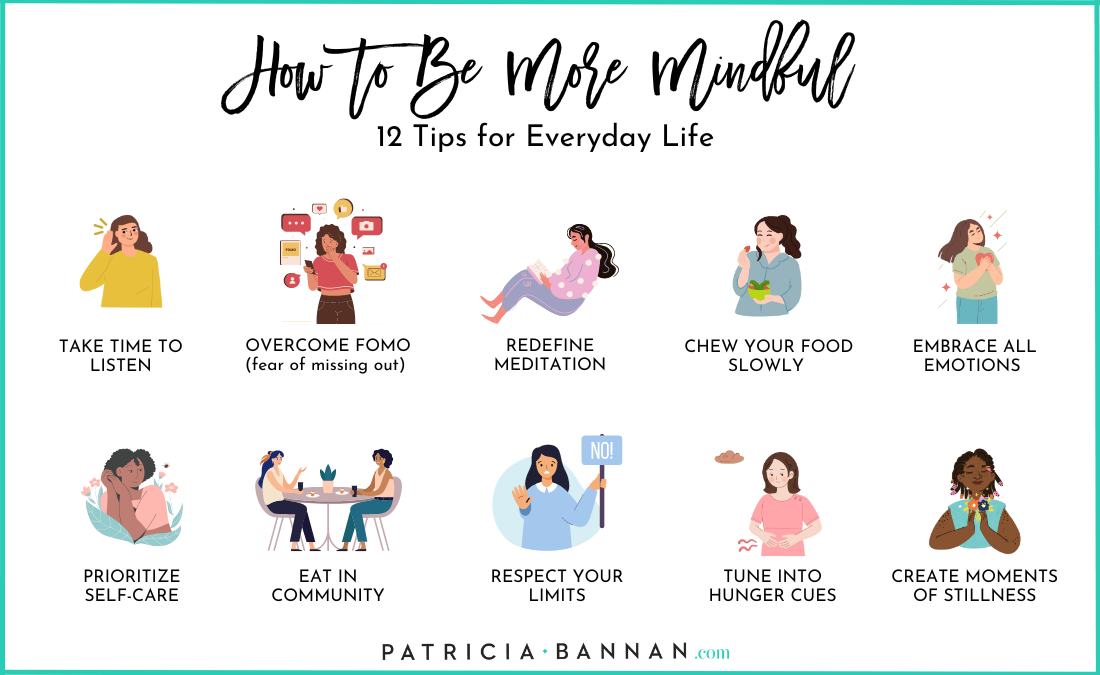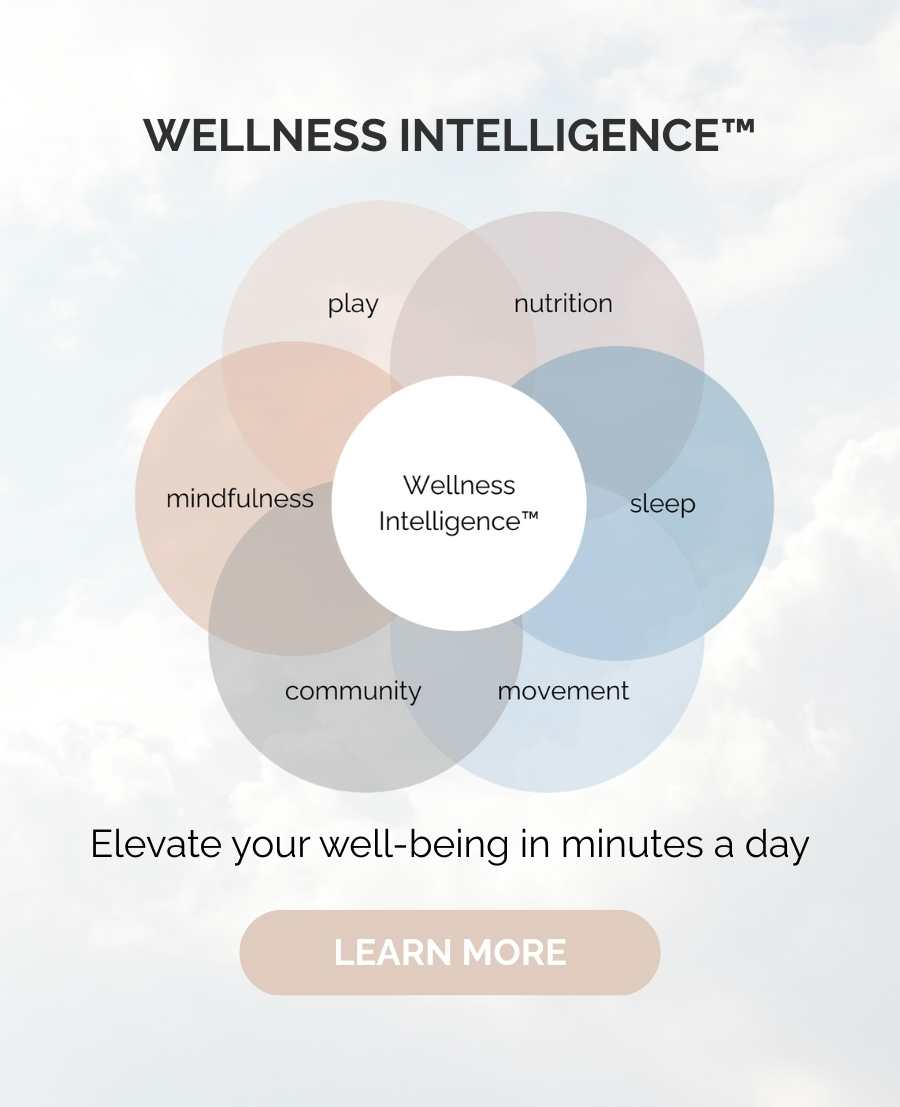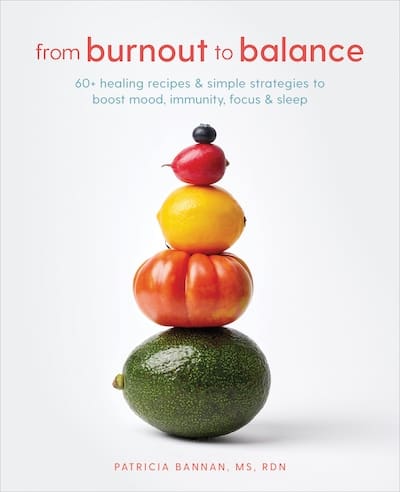Discover 12 practical tips on how to be more mindful in everyday life. Learn how to reduce stress, improve focus, and cultivate mindfulness through simple habits like mindful eating, listening, and tech breaks.
Mindfulness has become a buzzword in recent years, but what does being mindful mean? As a dietitian and wellness expert, I’ve spent years helping people develop healthier lifestyles, and mindfulness is at the core of that journey. It’s not about reaching perfection or maintaining a constant state of calm, but rather about being aware of your thoughts, feelings, and surroundings in a way that nurtures your mind and body.
Whether balancing work, family, or personal goals, mindfulness can help you stay grounded and focused on what truly matters. By making mindful choices, you enhance not only your mental and physical health but also the quality of your relationships and daily experiences.
Why Mindfulness Matters
Mindfulness is one of the core pillars of health and wellness because it fosters awareness, balance, and mental clarity. In today’s fast-paced world, where we’re constantly juggling multiple roles and responsibilities, mindfulness serves as a much-needed anchor. It helps us manage stress, avoid burnout, and make intentional choices that contribute to a more fulfilled life. Research even shows that practicing mindfulness can reduce anxiety, improve emotional regulation, and enhance overall well-being.
When we’re mindful, we’re not just reacting to life; we’re living it fully, with awareness. So here are 12 practical ways to better incorporate mindfulness into your daily routine.
1. Take Time to Listen
One of the most powerful ways to practice mindfulness is by truly listening. Have you ever finished a conversation only to realize you didn’t fully absorb what the other person said? I’ve found myself guilty of this too, especially during busy days when my mind is racing from one thing to the next.
Mindful listening means setting aside distractions and being fully present when someone is speaking. When you take time to really listen—whether it’s a friend, a family member, or a coworker— it deepens your connection and builds trust. It’s also a great reminder that mindfulness can be about being present in everyday interactions.
2. Overcome FOMO (Fear of Missing Out)
As someone who works in the health and wellness space, I’ve often seen how the fear of missing out (FOMO) drives people to overextend themselves. It’s tempting to say “yes” to every event, project, or opportunity, but mindfulness teaches us to check in with ourselves first.
Are you doing something because you truly want to, or because you feel obligated? I’ve learned that saying “no” can be an act of self-care, allowing us to focus on what truly matters and recharge when needed.
3. Redefine Meditation
When people hear the word “meditation,” they often imagine sitting still in silence for long periods. However, mindfulness can take many forms. Walking outside in nature or journaling can be just as meditative as a traditional practice. I also more recently learned of Tapping Meditation, a technique that has changed the approach to meditation for some of my clients.
The key is to engage in these activities fully, without distractions. Whether you enjoy reading, cooking, or playing with your kids, mindfulness can be found in any activity if you approach it with intention.
4. Chew Your Food Slowly
The next time you eat, turn off your phone, pull up a chair, and sit down at the table to enjoy your meal. Not only will this allow you to slow down, but it will also help you appreciate your dish. With each bite of food, force yourself to chew slowly, as this simple act will gently remind you to eat mindfully. Plus, research shows the more you chew your food the better you will digest it!
5. Embrace All Emotions
In today’s culture, there’s a lot of pressure to be positive all the time. But mindfulness is about embracing all emotions—even the uncomfortable ones. Whether you’re feeling frustrated, sad, or anxious, these feelings are a natural part of the human experience.
By acknowledging and accepting your emotions without judgment, you create space for growth and healing. Practicing this kind of emotional mindfulness can also lead to greater resilience and self-awareness.
6. Prioritize Self-Care
We’ve all heard the phrase, “You can’t pour from an empty cup,” and mindfulness reminds us just how true that is. One of the cornerstones of mindfulness is taking care of your mind and body. This means paying attention to what nourishes you and what drains you.
Perhaps self-care looks like getting enough sleep, staying active, and eating well. Or it may mean limiting exposure to negative content, whether it’s on social media or the news. I encourage you to create a self-care routine that nourishes your unique needs – read, take a bath, or spend time in silence. You know yourself best.
7. Cook and Eat Together as a Family
One of my favorite ways to cultivate mindfulness at home is with family meals. Cooking (and eating) together strengthens the family bond, creates memories, and increases laughter—all of which are vital for healthy relationships.
Data on family meals matter is positively overwhelming in terms of nourishing the spirit, brain, and health of all family members. And it doesn’t have to be a traditional family setup—eating with friends, neighbors, or anyone in your community can offer the same powerful benefits.
Get everyone involved in cooking with my tacos—a simple, fun way for all to participate in assembling the recipe, practice mindfulness, and build lasting memories.
8. Respect Your Limits
As a busy professional, it can be challenging to set boundaries. But mindfulness teaches the importance of knowing and recognizing your limitations. Whether it’s in your personal life or your work, knowing when to say “no” is essential to maintaining balance.
I’ve learned this the hard way—taking on too much can lead to burnout and overwhelm. By respecting your limits and setting boundaries, you give yourself the space to focus on what’s truly important, both mentally and emotionally.
9. Tune into Hunger Cues
Have you ever gone hours without eating only to end up with an angry, protesting stomach? This is your body’s way of letting you know that you need food to function at peak performance.
Are you eating because you’re genuinely hungry, or because you’re stressed or bored? The next time you feel hungry, take a moment to pause and check in with yourself. Are you craving something specific? Or are you reaching for food out of habit? Perhaps you’re dehydrated and need a tall glass of water. This simple practice can help you develop a more mindful and intuitive approach to eating.
10. Create Moments of Stillness
In our fast-paced world, stillness can feel like a luxury, but it’s essential for mindfulness. A great way to practice stillness is by creating small pauses throughout the day. Whether it’s letting the phone ring a few extra times before answering or taking a moment to enjoy the smell of your morning coffee, these small pauses can help you reconnect with the present moment.
You don’t need hours of meditation to cultivate mindfulness—sometimes, all it takes is a few intentional seconds of stillness.
11. Eat with Intention
We live in a culture that encourages eating on the go, but mindful eating means being intentional about what you put into your body. I always encourage my clients to ask themselves, “Is this food nourishing me, or is it just convenient?”
When we make conscious choices about our food, we not only nourish our bodies but also our minds. Eating with purpose means taking the time to appreciate the flavors, textures, and nutrients in your meals, which fosters a deeper connection to your health and well-being.
12. Take Regular Tech Breaks
Technology is one of the biggest distractions in our modern lives, and it can easily overwhelm us. Can you make a point to unplug each day, even if it’s just for a few minutes? Whether it’s a quick walk outside without your phone or spending time with your family tech-free, these moments of disconnection can help you reconnect with yourself.
Research shows that taking breaks from screens can reduce stress, improve focus, and enhance overall well-being. I encourage you to make tech breaks a daily habit, even if it’s just for five minutes.
How to Be More Mindful Daily
Mindfulness isn’t about perfection or reaching an end goal—it’s a journey that unfolds with practice. By incorporating these simple, yet powerful tips into your daily routine, you’ll start to experience a deeper sense of awareness, calm, and fulfillment. Whether it’s through mindful eating, intentional listening, or taking regular tech breaks, mindfulness is a tool that can transform your life, one moment at a time.
What are some of your favorite ways to practice mindfulness? Share your thoughts and experiences below—I’d love to hear from you!
References
- Guendelman S, Medeiros S, Rampes H. Mindfulness and Emotion Regulation: Insights from Neurobiological, Psychological, and Clinical Studies. Front Psychol. 2017;8:220. doi:10.3389/fpsyg.2017.00220
-
Hamada Y, Hayashi N. Chewing increases postprandial diet-induced thermogenesis. Sci Rep. 2021;11:23714. doi:10.1038/s41598-021-03109-x
-
Family Meals Movement. www.fmi.org. Accessed September 18, 2024. https://www.fmi.org/family-meals-movement
-
Devi KA, Singh SK. The hazards of excessive screen time: Impacts on physical health, mental health, and overall well-being. J Educ Health Promot. 2023;12:413. doi:10.4103/jehp.jehp_447_23







